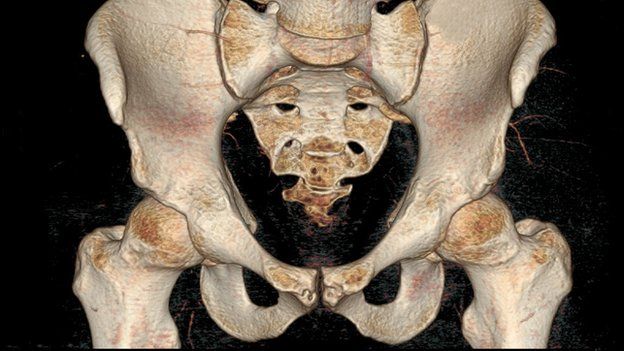Trauma care: CT scanner is 'merged' with A&E in hospital first
- Published

Doctors at a hospital in London are pioneering the use of rapid CT scans in an attempt to save the lives of seriously injured patients.
Some are being taken straight from the ambulance to a CT scanner at King's College Hospital, instead of A&E.
Doctors hope detailed images of the inside of a patient will help them pick the correct treatment more quickly.
The scanner also combines features of A&E so doctors can resuscitate patients without moving them.
About 20 of the hospital's patients have been treated this way so far.
In one case a man had fallen 25ft (8m) during a motorbike accident and had a serious head injury.
Tom Best, consultant in intensive care, said: "The question is does that patient need to go straight to theatre for life-saving surgery or not?"
Scans of the inside of the skull showed the patient was bleeding on the brain. However, the severity was not as bad as feared and "was not big enough to warrant an operation".
Within 11 minutes of the patient arriving at hospital, he was transferred to intensive care where the pressure inside his skull was controlled with medication.
Normally a patient would be taken to A&E first, assessed, stabilised and then taken to a CT scanner in another part of the hospital. However, Dr Best said the process could have taken up to half and hour in the past.
Faster scans
A computed tomography (CT) scan combines X-ray images taken from different angles to build a 3D view of the inside of the body.
It is more precise than a bedside X-ray machine or ultra-sound.
Dr Best told the BBC: "No-one has done it this way before.
"The thing about trauma is that it's all about speed, particularly in brain injury. Every minute of delay affects how bad the brain injury will be later.
"The key to managing trauma is rapid diagnosis and the key to diagnosis is the CT scan.
"The sooner you get that scan, the sooner you can stop the bleeding, the more likely you're going to save that patient's life."
The new scanner is built into a room next to the emergency department, which is also kitted out with the same gear as a typical bay in A&E.
Doctors and nurses step out of the room for 10 seconds while the scan takes place, and the pictures are available almost instantly.
The scan poses a radiation risk so only seriously injured patients, who would have needed a CT scan anyway, will take part in the trial.
However, it is too soon to know if the system saves lives.
King's is one of four dedicated major trauma centres in London.
Mr Rob Bentley, director of trauma at the hospital, said the new approach had the potential to save lives.
"We already know that patients have a better chance of survival - and a higher quality of life after an accident - if they are brought to a major trauma centre," he said.
"However, by taking patients straight to the CT scanner, we may be able to improve the service even further."
- Published23 October 2012
- Published7 June 2012